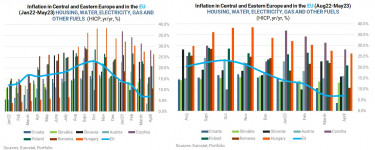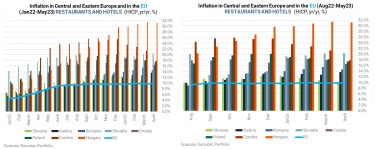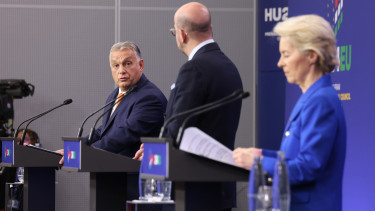Hungary's inflation remains on top of EU rankings in May too

Hungary stands out with its 21.9% yr/yr inflation rate in May, followed from afar by Poland and Czechia, both with a 12.5% reading.
The euro area annual inflation rate was 6.1% in May 2023, down from 7.0% in April. A year earlier, the rate was 8.1%. European Union annual inflation was 7.1% in May 2023, down from 8.1% in April. A year earlier, the rate was 8.8%. These figures were published by Eurostat, the statistical office of the European Union, on Friday.

It is important to note that the different dynamics are also the result of the base effect, a few months ago even the Baltic inflation was above 20%, and the rise in prices started earlier there, so the base was higher earlier. Due to the base effect, Hungarian inflation could fall below 10% by the end of the year.
Prime Minister Viktor Orbán said in an interview with public radio MR1 today that they aim for inflation to be "well below 10%" by year-end.
The lowest annual rates were registered in Luxembourg (2.0%), Belgium (2.7%), Denmark and Spain (both2.9%). 2.0% is the European Central Bank's (ECB) target, and it said just yesterday that further rate hikes could be expected, as they consider core inflation north of 5% to be of concern. Money markets boosted their bets on the ECB terminal rate to over 3.9% from the current 3.5%, which came to pass as the bank raised it by 25 basis points on Thursday.
Hungary's benchmark rate is 17% and the central bank (MNB) has already started a rate cut cycle.
Hungary vs. EU
Here are a couple of graphs that show how Hungary's inflation is different from the EU average and consumer price changes in its regional peers.
Average inflation in EU27 peaked in October 2022 and has been slowing ever since, while Hungary's inflation peaked in January this year and has been dropping very sluggishly, but the retreat in May was stronger than expected.

The huge gap seen above is nowhere in sight in the month-on-month readings, though. In fact, Hungary's m/m inflation was in negative territory at -0.4%, while it was flat in the EU (0.9%).

Food inflation in Hungary remains extremely high (34.1% yr/yr), not just compared to the EU average (15%).but also compared to CEE peers (see further below). However, it did come lower from the 47.9% peak last December.

In monthly terms, food prices edged 0.1% lower in Hungary and went up 0.4% in the EU27, which come after a respective 0.5% decline and a 0.1% growth in April.

The price of alcoholic beverages, tobacco and narcotics jumped 19.3% yr/yr in Hungary in May, by far the highest level in CEE, and more than double the EU average (8.4%). Yet, both figures mark a drop from the April prints.

The chart with m/m changes shows a smaller rise in this product group than the average for the bloc, which happened only three times over the past year.

Energy price increases have been moderating nicely both in Hungary and the EU.

The increase in the price of recreation and culture, as well as of restaurants and hotels moderated further, but the rate remains three times as high as the EU average. The m/m increases, however, were practically the same in Hungary and in the EU in May (0.1% HU, 0.4% EU in the former and 1.0% both in the latter product group).

At the end of 2022, there was an extreme divergence in how transport prices changed in Hungary (leaped) and in the EU (continued to drop), but even Hungarian price increases started to moderate in February at last. However, while the annual change in the EU came to 0% in May, Hungary's transport prices still showed a 14.5% yr/yr rise.

Regional radar
The following charts basically speak for themselves, showing that the annual harmonised index of consumer prices (HICP) in Hungary remains the highest in Central and Eastern Europe.
The left-hand charts show changes since January 2022, while the right-hand charts are for a shorter period between August 2022 and May 2023.

Hungary remains the champion not only in HICP, but also in terms of annual consumer price increases at food, alcohol, transport, restaurants and hotels, and recreation and culture, while Czechia, which dethroned Hungary in January, remains on top of the CEE rankings in terms of the annual price increase in housing, water, electricity, gas and other fuels, while Hungary took over again in electricity, gas and other fuels. (Click to enlarge!)







Cover photo: Getty Images








